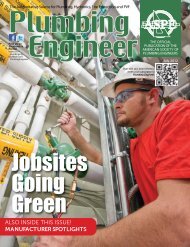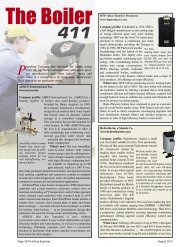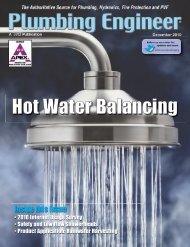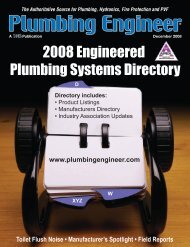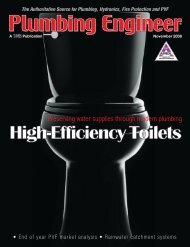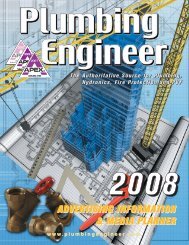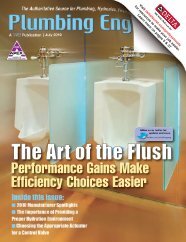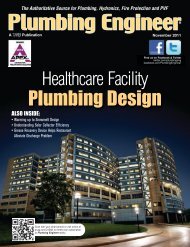open issue - Plumbing Engineer
open issue - Plumbing Engineer
open issue - Plumbing Engineer
Create successful ePaper yourself
Turn your PDF publications into a flip-book with our unique Google optimized e-Paper software.
tures. In addition, membrane filtration is used to remove<br />
color, which can occur from metal leaching and groundwater<br />
contamination. This is also used on potable rainwater<br />
systems to filter viruses, pyrogens and metal ions.<br />
In the event that the catchment surface is a parking lot<br />
or asphalt area, pretreatment for oil removal as well as<br />
emulsion breakers may be added to remove these additional<br />
contaminants.<br />
If chemical contamination is a concern, such as from<br />
heavy organic contamination, an oxidation process can<br />
be utilized, as well as organic membranes and slow sand<br />
filters (often referred to as bio-sand filters), which utilize<br />
a schmutzdecke to remove organic and biological<br />
impurities. (Schmutzdecke is a biological layer that<br />
forms on the surface of a slow sand filter and aids in the<br />
water purification process.)<br />
It is important in rainwater harvesting system design<br />
to understand upfront the source of the water as well as<br />
its end uses. This upfront knowledge will allow for proper<br />
system sizing to maximize the water that can be<br />
reclaimed and to identify the correct level of treatment<br />
for a safe and environmentally friendly system. n<br />
Resources<br />
1. Macomber, Patricia S. H., Guidelines for Rainwater<br />
Catchment Systems for Hawaii, College of Tropical<br />
Agriculture and Human Resources, University of<br />
Hawaii at Manoa, 2010.<br />
2. Texas Guide to Rainwater Harvesting, Texas<br />
Rainwater Development Board, 2002.<br />
3. Georgia Amendments to the 2006 International<br />
<strong>Plumbing</strong> Code, Appendix 1, “Rainwater Recycling<br />
Systems.”<br />
Mark Girgenti (markgirgenti@burtprocess.com) is<br />
the lead sales and design engineer for Burt Process<br />
Equipment, an environmental process design and equipment<br />
firm. Mark has spearheaded the design, integration,<br />
project management and construction of water<br />
treatment equipment for rainwater harvesting, graywater<br />
and high-purity water systems in the governmental,<br />
institutional, and pharmaceutical industries, both in the<br />
United States and abroad. Mark has been a speaker at<br />
numerous green building and plumbing events across<br />
the country and was a presenter at the ASPE 2011<br />
Technical Symposium. He holds a Bachelor’s degree in<br />
Chemical <strong>Engineer</strong>ing from Rensselaer Polytechnic<br />
Institute and a Master of Science in chemistry. He is<br />
actively involved in academic circles as a professional<br />
member of the Graduate Advisory Committee for<br />
Southern Connecticut State University as well as serving<br />
as a volunteer faculty member.<br />
Circle 34 on Reader Reply Form on page 69<br />
<strong>Plumbing</strong> <strong>Engineer</strong> April 2012/Page 53



